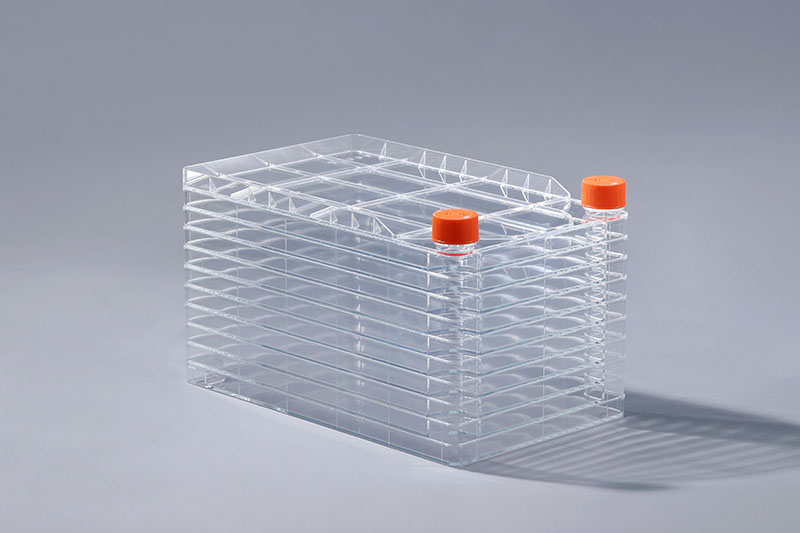So širokým využitím bunkových kultúr v oblasti biologických vied sa Ideálny osmotický tlak sa mení podľa typu a rasy buniek. Osmotický tlak ľudskej plazmy je 290 mmol/l, čo sa považuje za ideálny osmotický tlak na kultiváciu ľudských buniek in vitro. Osmotický tlak buniek cicavcov je všeobecne 290 až 300 mmol/l. Ľudské embryonálne pľúcne fibroblasty majú 250 až 325 mmol/l a myši približne 310 mmol/l. V praktických aplikáciách je osmotický tlak 260-320 mmol/l vhodný pre väčšinu buniek. O dôležitosti vhodného osmotického tlaku pri kultivácii buniek v bunkových továrňach niet pochýb. Okrem toho sú základnými podmienkami bunkovej kultúry vhodná teplota, plynné prostredie a hodnota pH, netoxicita a sterilita. široko používajú ako spotrebné bunkové kultúry v oblastiach výroby a prípravy vakcín, monoklonálnych protilátok, kmeňových buniek a somatických buniek. Bunkový rast má prísne požiadavky na prostredie a vhodný osmotický tlak je základom pre udržanie dobrého rastového stavu buniek. Bunky v hypertonických alebo hypotonických roztokoch sa okamžite zmenšujú, napučiavajú a praskajú. Preto je správny osmotický tlak jednou z dôležitých podmienok pre kultiváciu buniek v bunkových továrňach. Udržiavanie osmotického tlaku buniek tkaniva cicavcov a iných živočíšnych tkanív in vitro súvisí najmä s chloridom sodným, ale nemožno ignorovať vzťah osmotického tlaku iných dielektrík. Osmotický tlak je úmerný počtu molekúl a iónov rozpustenej látky v jednotkovom objeme rozpúšťadla a iónová rovnováha v kultivačnom médiu sa riadi podľa určitého podielu. Udržiavanie normálneho osmotického tlaku nie je len na udržanie bunkového napätia, ale zohráva dôležitú úlohu aj pri regulácii bunkového metabolizmu. Pretože extracelulárny transport iónov a koncentrácia iónov mení transport iných živín, priamo ovplyvňuje základný systém syntézy buniek.
Cells in hypertonic or hypotonic solutions immediately shrink, swell, and rupture. Therefore, proper osmotic pressure is one of the important conditions for culturing cells in cell factories. The maintenance of osmotic pressure of mammalian and other animal tissue cells in vitro is mainly related to sodium chloride, but the relationship of osmotic pressure of other dielectrics cannot be ignored. The osmotic pressure is proportional to the number of molecules and ions of the solute in the unit volume of the solvent, and the ion balance in the culture medium is controlled according to a certain proportion. Maintaining a normal osmotic pressure is not only to maintain cell tension, but also plays an important role in regulating cell metabolism. Because extracellular ion transport and ion concentration alter the transport of other nutrients, it directly affects the basic synthesis system of cells.
The ideal osmotic pressure varies with the type and race of cells. The osmotic pressure of human plasma is 290 mmol/L, which is considered to be the ideal osmotic pressure for culturing human cells in vitro. The osmotic pressure of mammalian cells is generally 290 to 300 mmol/L. Human embryonic lung fibroblasts are 250-325 mmol/L, and mice are about 310 mmol/L. In practical applications, the osmotic pressure of 260-320 mmol/L is suitable for most cells.
The importance of appropriate osmotic pressure when culturing cells in cell factories is beyond doubt. In addition, appropriate temperature, gas environment and pH value, non-toxicity and sterility are the basic conditions for cell culture.
The FAI climbed 5.9 percent year-on-year in the first 11 months of 2018, quickening from the 5.7-percent growth in Jan-Oct, the National Bureau of Statistics (NBS) said Friday in an online statement.
The key indicator of investment, dubbed a major growth driver, hit the bottom in August and has since started to rebound steadily.
In the face of emerging economic challenges home and abroad, China has stepped up efforts to stabilize investment, in particular rolling out measures to motivate private investors and channel funds into infrastructure.
Friday's data showed private investment, accounting for more than 60 percent of the total FAI, expanded by a brisk 8.7 percent.
NBS spokesperson Mao Shengyong said funds into weak economic links registered rapid increases as investment in environmental protection and agriculture jumped 42 percent and 12.5 percent respectively, much faster than the average.
In breakdown, investment in high-tech and equipment manufacturing remained vigorous with 16.1-percent and 11.6-percent increases respectively in the first 11 months. Infrastructure investment gained 3.7 percent, staying flat. Investment in property development rose 9.7 percent, also unchanged.
 English
English



















































